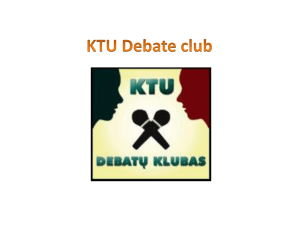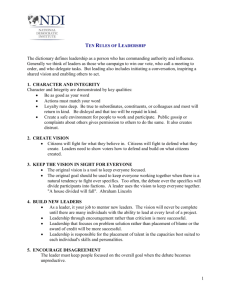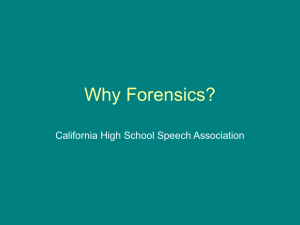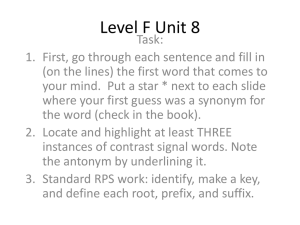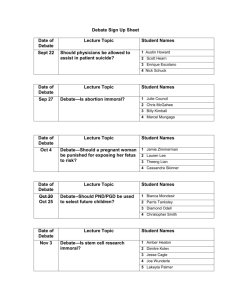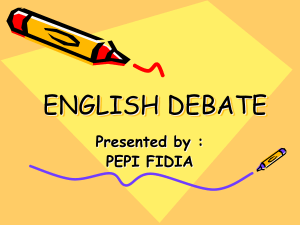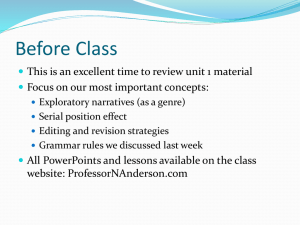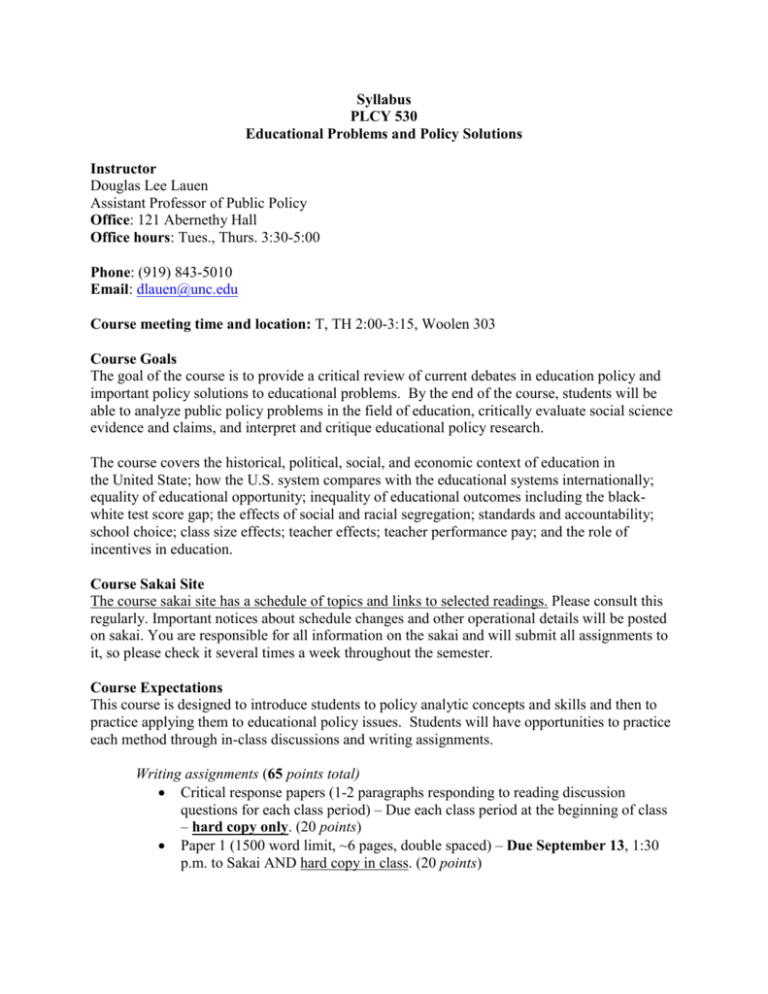
Syllabus
PLCY 530
Educational Problems and Policy Solutions
Instructor
Douglas Lee Lauen
Assistant Professor of Public Policy
Office: 121 Abernethy Hall
Office hours: Tues., Thurs. 3:30-5:00
Phone: (919) 843-5010
Email: dlauen@unc.edu
Course meeting time and location: T, TH 2:00-3:15, Woolen 303
Course Goals
The goal of the course is to provide a critical review of current debates in education policy and
important policy solutions to educational problems. By the end of the course, students will be
able to analyze public policy problems in the field of education, critically evaluate social science
evidence and claims, and interpret and critique educational policy research.
The course covers the historical, political, social, and economic context of education in
the United State; how the U.S. system compares with the educational systems internationally;
equality of educational opportunity; inequality of educational outcomes including the blackwhite test score gap; the effects of social and racial segregation; standards and accountability;
school choice; class size effects; teacher effects; teacher performance pay; and the role of
incentives in education.
Course Sakai Site
The course sakai site has a schedule of topics and links to selected readings. Please consult this
regularly. Important notices about schedule changes and other operational details will be posted
on sakai. You are responsible for all information on the sakai and will submit all assignments to
it, so please check it several times a week throughout the semester.
Course Expectations
This course is designed to introduce students to policy analytic concepts and skills and then to
practice applying them to educational policy issues. Students will have opportunities to practice
each method through in-class discussions and writing assignments.
Writing assignments (65 points total)
Critical response papers (1-2 paragraphs responding to reading discussion
questions for each class period) – Due each class period at the beginning of class
– hard copy only. (20 points)
Paper 1 (1500 word limit, ~6 pages, double spaced) – Due September 13, 1:30
p.m. to Sakai AND hard copy in class. (20 points)
Paper 2 topic statement – one page, single spaced – Due October 16, 1:30 to
Sakai AND hard copy in class. (5 points)
Paper 2 (1500 word limit, double spaced. ~6 pages) – Due November 29, 1:30 to
Sakai AND hard copy in class. (20 points)
An in-class debate (10 points)
Teams of 3-4 students will debate policy issues. Using a debate scoring rubric,
points will be awarded to each team based on instructor and student evaluation.
Final Exam (15 points)
The final exam will test your ability to synthesize the content of the course and
use concepts to interpret an education policy case and/or policy problem. You will
receive 3-5 essay prompts and be required to choose 1-2 of them.
Professor discretion – (10 points)
Attendance and in-class discussion quantity and quality.
Debate Days
Some classes are designated as “Debate Days” with a specific debate question. You must sign up
for one debate via a wiki page. On these days your team must prepare both sides of a debate
question. Sides of the debate will be assigned by coin toss at the beginning of class. Debate
teams must be no fewer than three students and no more than four students. Your grade for this
assignment will be determined by three factors: a) student audience evaluation of debate
performance, b) professor evaluation of debate performance, and c) group member peer
evaluations of your contribution to your team's preparation for the debate.
Rules: Team members must meet together to prepare. All members of the team must participate
in the debate. You are strongly encouraged to do outside research to buttress your arguments. At
the end of each class a secret ballot will determine who wins the debate and who wins best
debater award. Two extra credit points will be awarded for the student who is deemed by the
students and the professor as the best debater. In the case of a tie, one extra credit point will be
awarded to each student. Points will be awarded to teams based on student votes and professor
judgment. Deadline for signing up for a debate team: 9/27.
For those not participating in the debate, your response paper should briefly argue the debate
question. You must pick a side. At the end of the debate, you will handwrite answers to the
following questions: 1) what was your view before the debate (the side you argued in your paper)
2) what is your view now (did you change your mind), 3) which team you think won the debate,
and 4) which student should win the best debater award?
Grading
The following definitions of grades were adopted by the University Faculty and are the official
basis for assigning and interpreting undergraduate grades. Note that they are based on
performance, not on effort or on individual improvement:
A - Mastery of course content at the highest level of attainment that can reasonably be
expected of students at a given stage of development. The A grade states clearly that the
student has shown such outstanding promise in the aspect of the discipline under study
that he/she may be strongly encouraged to continue.
B - Strong performance demonstrating a high level of attainment for a student at a given
stage of development. The B grade states that the student has shown solid promise in the
aspect of the discipline under study.
C - A totally acceptable performance demonstrating an adequate level of attainment for a
student at a given stage of development. The C grade states that, while not yet showing
any unusual promise, the student may continue to study in the discipline with reasonable
hope of intellectual development.
D - A marginal performance in the required exercises demonstrating a minimal passing
level of attainment for a student at a given stage of development. The D grade states that
the student has given no evidence of prospective growth in the discipline; an
accumulation of D grades should be taken to mean that the student would be well advised
not to continue in the academic field.
F - For whatever reasons, an unacceptable performance. The F grade indicates that the
student's performance in the required exercises has revealed almost no understanding of
the course content. A grade of F should warrant an adviser's questioning whether the
student may suitably register for further study in the discipline before remedial work is
undertaken.
Grade Appeal Policy
I take the evaluation and grading of your work very seriously because I know that most of you
take the preparation and writing of your work very seriously. If you think you deserve a higher
grade on a non-revisable paper or exam, you may write a letter and explain why you would like
to appeal the grade. Before making an appeal, you should review the grading criteria and
grading comments and re-read your paper/exam with these in mind. After I receive your letter, I
will re-read your paper/exam. Depending on my re-reading, your grade may stay the same, be
raised, or be lowered. This system is designed to minimize frivolous grade appeals and to
ensure that you have carefully examined and reflected on the quality of your work before
deciding to initiate a grade appeal.
Late Assignments and Extensions
Policy on Critical Response Papers
These will only be accepted at the beginning of class. (No email copies, no copies uploaded to
Sakai.) These papers will not be returned. I will excuse a maximum of four response papers; any
more than four missing papers will count against your grade. I will not accept late response
papers. Make up papers will be allowed only in rare circumstances (e.g., serious illness, death in
the family, see below).
Policy on Paper 1, Paper 2 topic statement, and Paper 2
Points will be subtracted from late assignments at a rate of ten percent of total point value per
day. All assignments will submitted to sakai for a “date and time stamp” and then also in class in
hard copy. The late assignment policy will apply to the date and time on which an assignment
was received by sakai. If technical problems prevent you from submitting your first assignment
to sakai, you will receive an automatic grace period of 24 hours provided you also submit
documentation that your technical problem was genuine (e.g., a tech support “help ticket.”). No
such grace periods will apply to assignments subsequent to the first. You are expected to verify
that your assignments have been properly submitted.
If personal or extenuating circumstances prevent you from turning in an assignment on time,
please contact me as soon as possible in advance of the deadline. Extensions will be handled on a
case-by-case basis, but job interviews, work commitments, extracurricular activities, weddings,
travel plans, and academic workload issues will not be considered valid reasons for extensions.
Serious medical emergencies and other unexpected events, with documented proof, may be
grounds for an extension.
Norms of academic behavior
The purpose of class time is to enhance your understanding of material covered in the course
reading. To state the obvious, to get the most out of these experiences you must come to class
prepared and on time, get enough sleep the night before, and avoid any distractions that might
hinder your learning. Failing to read outside of class, coming to class late, falling asleep and/or
text messaging during class wastes your time, my time, and insults your fellow students. During
class time, however, please refrain from using electronic devices (phones, MP3 players, and
laptops). Anyone caught using an electronic device for an inappropriate use during lecture will
have the device confiscated for the class period or asked to leave. Anyone caught twice for such
an infraction will face further disciplinary action including low marks for class participation.
Honor Code
The honor code is on effect in this class and all others at the University. We treat Honor Code
violations seriously and urge all students to become familiar with its terms set out at
http://instrument.unc.edu. If you have questions, it is your responsibility to ask us about the
Code’s application. It is assumed that all exams, written work and assignments submitted by you
are in compliance with the requirements of the Honor Code.
Academic Integrity/Plagiarism
In order to ensure effective functioning of the Honor System at Carolina, all students are
expected to:
a. Conduct all academic work within the letter and spirit of the Honor Code, which prohibits the
giving or receiving of unauthorized aid in all academic processes. If unsure about the limits of
group work versus individual work on papers and projects, ask the instructor. Do not guess.
b. Consult with faculty and other sources to clarify the meaning of plagiarism; to learn the
recognized techniques of proper attribution of sources used in written work; and to identify
allowable resource materials or aids to be used during completion of any graded work.
c. Sign a pledge on all graded academic work certifying that no unauthorized assistance has been
received or given in the completion of the work.
d. Treat all members of the University community with respect and fairness.
e. Report any instance in which reasonable grounds exist to believe that a student has given or
received unauthorized aid in graded work or in other respects violated the Honor Code. Reports
should be made to the office of the Student Attorney General.
At UNC, plagiarism is defined as "the deliberate or reckless representation of another's words,
thoughts, or ideas as one's own without attribution in connection with submission of academic
work, whether graded or otherwise." (Instrument of Student Judicial Governance, Section
II.B.1.). Because it is considered a form of cheating, the Office of the Dean of Students can
punish students who plagiarize with course failure and suspension. Full information can be found
on the UNC Honor System page UNC Writing Center Handout:
http://writingcenter.unc.edu/resources/handouts-demos/citation/plagiarism)
Staying Current
To help improve the quality of discussion in class, I encourage you to form study groups and
follow debates regarding current policy issues. To follow current policy debates:
1. Read Education Week, the trade publication for education leaders, researchers, and
policymakers. www.edweek.org. Back issues available through the electronic resources
of the UNC library’s website: http://eresources.lib.unc.edu/ejournal/.
2. Read education policy blogs. Here are some decent ones:
1. http://voices.washingtonpost.com/class-struggle/
2. http://blogs.edweek.org/edweek/Bridging-Differences/
3. http://eduoptimists.blogspot.com/
4. http://www.quickanded.com/
5. http://scholasticadministrator.typepad.com/thisweekineducation/
3. Read the newspaper. Consider subscribing to The New York Times. They offer
significantly reduced subscription rates for students. The New York Times
(http://www.nytimes.com), and Washington Post (http://washpost.com/index.shtml) can
be read on-line. In some cases, you can even set things up so that articles will be sent
directly to your e-mail account.
4. Review the Congressional Quarterly available in the library and at www.cq.com. CQ
Weekly provides weekly updates and analysis of current legislative initiatives.
5. Examine congressional hearings and reports on a topic by using Thomas
at http://thomas.loc.gov/.
6. Get to know what Congressional representatives and senators work on specific topics by
reviewing their websites on http://www.senate.gov/, http://www.house.gov/).
7. Get to know the President’s viewpoint and the viewpoints of the President’s cabinet
by visiting http://www.whitehouse.gov/.
Course Schedule and Readings
Introduction
1.
2.
8/21 Course Introduction
8/23 Warm Up Discussion 1
CQ Researcher, April 29, 2011, School Reform
DQs: Is there a crisis in American education today? If so, what are the main problems?
What problems are schools responsible for and what problems are they not
responsible for?
Analysis of Policy Problems
3.
8/28 Analysis of Policy Problems
Weimer, D. L. and A. R. Vining (2004) Policy analysis: concepts and practice. Upper
Saddle River, NJ, Pearson Prentice Hall. Ch. 14, “Landing on Your Feet: How to
Confront Policy Problems,” 324-343
Kraft, M. E. and S. R. Furlong. (2007) “Assessing Policy Alternatives” in Public policy:
politics, analysis, and alternatives. Washington, D.C., CQ Press. 151-160.
DQs: Define an educational policy problem that interests you. What are its root and
proximal causes? How would we know if an educational policy solution is equitable?
What are some ways we could define equity in educational policy?
4.
8/30 Educational Goals
Labaree, David F. 1997. "Public Goods, Private Goods: The American Struggle over
Educational Goals." American Educational Research Journal 34:39-81.
DQs: What are the three goals of American education? Is the fact that there are multiple
goals for education inherently problematic?
5.
9/4 Warm Up Discussion 2
Mosteller, Frederick (1995) “The Tennessee Study of Class Size in the Early School
Grades” The Future of Children, 5:113-127.
Stecher et al. 2001. “Class-Size Reduction in California: A Story of Hope, Promise, and
Unintended Consequences. Phi Delta Kappan, v82 n9 p670-74.
DQs: What are the pros and cons of reducing class size as a policy alternative?
Social, Political, and Historical Context
6.
9/6 Historical context
Brint, S. G. (2006) “Historical Context.” Schools and societies. Stanford, Calif., Stanford
University Press.
Tyack, D. (1999) “Preserving the Republic by Educating Republicans,” in Smelser, N. J.
and J. C. Alexander, Diversity and its discontents: cultural conflict and common
ground in contemporary American society. Princeton, N.J., Princeton University
Press.
DQs: What are the ideals of civic republicanism and are they a legitimate basis of
American schooling?
7.
9/11 Governance & Finance
Corcoran & Goertz. (2005) “The Governance of Public Education,” in Fuhrman, S. and M.
Lazerson, The public schools. Oxford; New York, Oxford University Press. Pages
25-43 ONLY.
Springer, Houck, Guthrie. “History and Scholarship Regarding United States Education
Finance and Policy.”
DQs: What are the advantages and disadvantages of the U.S.’s system of strong local
control over education?
8.
9/13 International comparisons
Brint, S. G. (2006) “Six Schooling Systems.” In Schools and societies. Stanford, Calif.,
Stanford University Press.
Miller et al 2009 Comparative Indicators of Education in the United States and Other G-8
Countries: 2009. Read Summary and Appendix A (pp. 81-98) and 2-3 indicators in
part II (academic achievement), and indicators 17 (time), 22 & 23 (spending), and 27
(returns to degree).
DQs: Which country has the best education system and why: U.S., Germany, Japan?
DUE: Paper 1, 6 pages, 1500 words
Inequality in Educational Opportunity and Outcomes
9.
9/18 Effects of family background
Coleman, James S., et al. (1966) Equality of Educational Opportunity. Washington:
USGPO, pp. iii-iv, 1-33, 290-319.
Jencks, C. (1972) Inequality; a reassessment of the effect of family and schooling in
America. New York, Basic Books. Pp 176-246, 253-265
DQs: What were the common assumptions about the effects of schooling during the 1960s
and how did these studies alter these assumptions? Are the findings of these dated
reports still relevant to current education policy debates? If so, how?
10.
9/20 The black-white test score gap
Jencks, C. and M. Phillips. (1998) The black-white test score gap. Washington, D.C.,
Brookings Institution Press: Jencks and Phillips. “The Black-White Test Score Gap:
An Introduction”
Vanneman et al. 2009. “Achievement Gaps: How Black and White Students in Public
Schools Perform in Mathematics and Reading on the National Assessment of
Educational Progress.” Statistical Analysis Report. NCES 2009-455.
Note: this is a long statistical analysis report. The purpose of this report is to provide you
with the most up to date figures on the black-white gap. Read pages 1-5 and make
note of recent changes in the black-white test score gap. In the state-by-state figures
focus on North Carolina and/or your home state.
DQs: What do you think accounts for the large disparity in test scores between black and
white students? Is the black-white test score gap essentially the same across U.S.
states?
11.
9/25 Segregation, Desegregation, and Resegregation
Ravitch, D. (1983) The troubled crusade: American education, 1945-1980. New York,
Basic Books. “Race and Education: The Brown Decision”
Jost, K. (2010) “Racial Diversity in Public Schools: Has the Supreme Court Dealt a Blow
to Integration?” CQ Researcher, 17: 745-768.
DQs: What was the basis of the harm suffered by the plaintiffs in the Brown case? What is
the current status of school desegregation as a policy alternative?
12.
9/27 Tracking and “Acting White”
Tyson, Karolyn (2011). “Integration Interrupted: Tracking, Black Students, and Acting
White after Brown” Oxford University Press. Chapters Intro, 1, 2
Discussion Qs TBA
Due: sign up for a debate topic and team
13.
10/2 Tracking and “Acting White”
Tyson, Karolyn (2011). “Integration Interrupted: Tracking, Black Students, and Acting
White after Brown.” Oxford University Press. Chapters 3, 4, Conclusion
Discussion Qs TBA
14.
10/4 School Assignment Policies in Wake County – DEBATE DAY
Grant, Gerald. 2009. Hope and Despair in the American City: Why there are no bad
schools in Raleigh. Chapter 4 “There Are No Bad Schools in Raleigh.”
Goldsmith & Hui. 2010. “Tumultuous session ends diversity policy.” Raleigh News
Observer. March 24, 2010.
Bazelton, Emily. 2008. “The Next Kind of Integration.” New York Times Magazine. July
20.
Debate Question: "Have Recent Changes in School Assignment Policies in Wake County
Enhanced Equality of Educational Opportunity?"
15.
10/7 Early childhood I
Loeb & Bassok. 2008. “Early Childhood and the Achievement Gap.” AEFA Handbook
Heckman (2006) “Skill Formation and the Economics of Investing in Disadvantaged
Children.” Science 312:1900-1902.
Chetty et al (2010) “$320,000 Kindergarten Teachers.” Phi Delta Kappan 92:22-25.
DQs: What role do families play in producing student outcomes? Do schools reduce or
widen inequality in cognitive outcomes between age 5 and 12?
16.
10/7 Early childhood II
Hart & Risley 2003 “The Early Catastrophe: The 30 Million Word Gap by Age 3”
American Educator, Spring 2003, pp. 4-9.
Lareau 2002, “Invisible Inequality: Social Class and Childrearing in Black Families and
White Families.” American Sociological Review. 67(5): 747-776.
How do middle class families transmit social advantages to their children? How do these
practices shape student behavior and achievement in school?
Standards and Accountability
17.
10/16 Nation at Risk
Edward B. Fiske. “35 Pages that Shook the U.S. Education World.” New York Times, 27
April 1988. p. 24.
United States National Commission on Excellence in Education. (1983) A nation at risk:
the imperative for educational reform: a report to the Nation and the Secretary of
Education, United States Department of Education. Washington, D.C. Read
everything except the appendices. http://www2.ed.gov/pubs/NatAtRisk/index.html
Debate Question: "Is the U.S. Educational System Failing and if so, How and Why?"
DUE: Final paper topic statement (1 page)
18.
10/23 Accountability
Figlio & Ladd. 2008. “School Accountability and Student Achievement.” AEFA
Handbook.
Campbell, Donald T. 1979. “Assessing the Impact of Planned Social Change.” Evaluation
and Program Planning. 2. Pp. 84-86, Corrupting Effect of Quantitative Indicators,
only.
DQs: Who wants school based accountability and why? What are the pros and cons of
school based accountability?
19.
10/25 Federal Accountability Policy – DEBATE DAY
Dee & Jacob (2011) “The Impact of No Child Left Behind on Student Achievement,”
Journal of Policy Analysis and Management, 30: 418-446.
Jost, K. (2010) “Revising No Child Left Behind?” CQ Researcher, 15: 337-360.
Debate Question: "Should the Federal Government Maintain Strong Accountability
Provisions in the Next ESEA Act, and if so, What Should They Entail?"
School Choice
20.
10/30 School choice - theory
Friedman, Milton (1962) The Role of Government in Education, in Friedman ed.
Capitalism and Freedom, pp. 85-107.
Chubb, J. E. and T. M. Moe. (1990) Politics, markets, and America's schools. Washington,
D.C., Brookings Institution. Chapter 6.
DQs: What is the problem with government-managed schooling? How do the policy
alternatives offered by these two readings differ?
21.
11/1 School choice - politics and research – DEBATE DAY
Schemo, Diana (2004) “Charter Schools Trail in Results, U.S. Data Reveals” New York
Times, August 17, p. A1.
Henig, Jeffrey (2008) Spin Cycle: How Research is Used in Policy Debates: The Case of
Charter Schools. Chapters 4 and 5.
Debate Question: "Is there Sufficient Evidence to Expand School Choice through Public
Policy? If so, how"
22.
11/6 Charter school effects
Credo, 2009. Multiple Choice: Charter School Performance in 16 States. Research Report.
Lauen et al Los Angeles charter school working paper
DQs: Is there evidence that charter schools are any worse or any better than traditional
public schools?
23.
11/8 Charter school start up – TBA
Discussion Qs TBA
Teacher Effects, Evaluation, and Performance Pay
24.
11/13 Teacher Effects
Goldhaber. 2008. “Teachers Matter, but Effective Teacher Quality Policies are Elusive.”
AEFA Handbook.
DQs: What do you think are the most important pieces of evidence from this literature
review? What are the policy implications from the evidence you highlight?
25.
11/15 Teacher value added
Harris, Douglas (2011) Value Added Measures in Education. Chapters 4 and 6.
Sanders, W. and Horn, S. 1998. “Research Findings from the Tennessee Value-Added
Assessment System (TVASS) Database: Implications for Educational Evaluation and
Research.” Journal of Personnel Evaluation in Education. 12:3. 247-256.
Debate Question: "Should teacher value added estimates be used to evaluate teachers? If
so, how?"
26.
11/20 Distribution of high quality teachers
Boyd, Lankford & Wyckoff. 2008. “Increasing the Effectiveness of Teachers in LowPerforming Schools.” AEFA Handbook.
Lauen et al distribution of teacher value added paper
DQs: Do poor and minority kids have worse access to high quality teachers? If so, what
should be done to solve this problem?
27.
11/27 Teacher value added and evaluation – DEBATE DAY
Harris, D. N. and Hill, H.(2009) point-counterpoint on “Should Value Added Models be
Used to Evaluate Teachers?” Journal of Policy Analysis and Management, 28(4),
692-712.
Glazerman et al 2010. "Evaluating Teachers: The Important Role of Value-Added."
Brookings Brown Center Task Group on Teacher Quality. Nov. 17, 2010.
Debate Question: “Should value added models be used to evaluate teachers? Why or why
not?”
28.
11/29 Pay for performance – DEBATE DAY
Springer et al (2011) Point Report. I. Executive Summary and V. Discussion of Findings,
only.
Marsh & McCaffrey (2010). “What are achievement gains worth – to teachers?” Phi Delta
Kappan 93: 52.
Debate Question: "Should teachers be rewarded for their student's test score performance?
If so, how?"
DUE: Paper 2, 1500 words
29.
12/4 TBD


